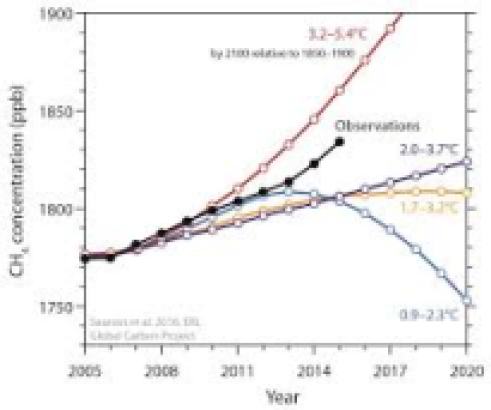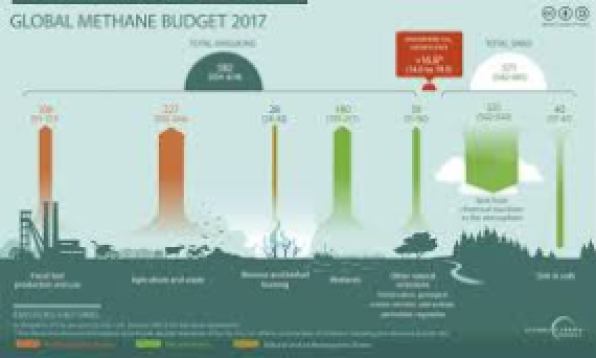
THE METHANE FEAROLOGY
MARIELLE SAUNOIS …..

… AND HER METHANE OBSESSION

FILE -In this June 12, 2014 file photo, oil pumps and natural gas burn off in Watford City, N.D. The Interior Department says it is replacing an Obama-era regulation aimed at restricting harmful methane emissions from oil and gas production on federal lands. A rule being published in the Federal Register this week will replace the 2016 rule with requirements similar to those that were in force before the Obama administration changed the regulation. (AP Photo/Charles Rex Arbogast, File)


THIS POST IS A CRITICAL REVIEW OF A SCIENCE ALERT ARTICLE [LINK] REPORTING THE RESULTS OF THE MARIELLE SAUNOIS 2020 PAPER
WHAT THE SCIENCE ALERT ARTICLE SAYS
- Methane Emissions Have Jumped a Staggering Nine Percent Since Last Decade
- Emissions of methane – a planet-warming gas several times more potent than carbon dioxide – have risen by nine percent in a decade driven by humanity’s insatiable hunger for energy and food.
- Methane has a warming potential 28 times greater than CO2 over a 100-year period and its concentration in the atmosphere has more than doubled since the Industrial Revolution.
- Over a 20-year period, it is more than 80 times as potent. While there are a number of natural methane sources such as wetlands and lakes, the the study concluded that 60 percent of CH4 emissions are now manmade.
- These sources fall principally into three categories: extracting and burning fossil fuels for power, agriculture including livestock, and waste management.
- The 2015 Paris climate agreement saw nations commit to limit temperature rises to „well below“ two degrees Celsius (3.6 Farenheit) above pre-industrial levels. The levels of atmospheric methane are increasing by around 12 parts per billion each year.
- This trajectory is in line with a scenario modelled by the IPCC that sees Earth warming as much as 3 to 4 degrees Celsius by 2100.
- „Regular updates of the global methane budget are necessary because reducing methane emissions would have a rapid positive effect on climate.
- To meet the objectives of the Paris Agreement, not only do CO2 emissions need to be reduced but also methane emissions.
- The Global Carbon Project, a consortium of more than 50 research institutions around the world, has gathered data from more than 100 observation stations.
- The world now produces around 50 million additional tonnes of methane every year than it did between 2000-2006.
- Around 60 percent of human-made CH4 emissions were estimated to come from agriculture and waste, including as much as 30 percent from the digestive processes of cattle and sheep. Twenty-two percent comes from the extraction and burning of oil and gas, while 11 percent leaks from the world’s coal mines, the study found.
- But recent studies based on new techniques for spotting methane leaks using satellite data suggest that emissions from the oil and gas sector may be significantly higher than those shown in the study, which only included data through 2017.
- Short-term threat: While the overall trend is upwards, emissions levels fluctuate between regions. For instance, Africa, China and Asia each produce 10-15 million tonnes annually. The US churns out around 4-5 million tonnes. Europe is the only region where methane emissions are falling – between 2-4 million tonnes since 2006, depending on the estimation method.
- The United Nations says that to hit the more ambitious Paris target of a 1.5 degrees Celsius warming cap, all greenhouse gas emissions must fall by 7.6 percent annually this decade.
CRITICAL COMMENTARY
- Anthropogenic global warming and climate change (AGW) is a theory about the impact of the industrial economy on climate specifically in terms of the combustion of fossil fuels and the artificial carbon dioxide emissions thus caused. This is why the amount of warming caused by AGW is assessed as „since pre-industrial“. AGW is not a theory about how wetlands, cattle, and other natural sources of carbon have caused warming because of the industrial revolution. Specifically, AGW climate change relates to the anthropogenic emissions of carbon dioxide from the combustion of fossil fuels in the industrial economy and not to carbon cycle flows.
- This issue is explained by NASA climate scientist Dr. Peter Griffith on this video. {Link to the source on Youtube [LINK] .https://video.wordpress.com/embed/jPL8W6WQ?
- https://videos.files.wordpress.com/jPL8W6WQ/bandicam-2020-06-19-08-02-11-028_dvd.mp4
- Details of this issue are provided in related posts [LINK] , [LINK] , [LINK].
- It should also be noted that methane is unstable in the atmosphere where it readily spontaneously oxidizes to carbon dioxide with a half life of about 5 years. That methane is a much stronger greenhouse gas than carbon dioxide is therefore not relevant at the longer time scales of 60 years or more at which the warming due to the greenhouse effect of AGW can be found in the data. At longer time scales, the net effect of methane emissions in the atmosphere is its oxidized form as CO2.
- More to the point the decadal time scales used in methane studies is known to be too short to assess its effect on climate. Climate science contains the important time scale limitation that limits the interpretation of anthropogenic global warming to time scales greater than 30 years and to a global geographical span. It is found that at shorter time scales, and particularly so at the decadal time scale used in methane studies, the impact of AGW on climate is confounded by nature in what is termed „internal climate variability„. This issue is presented in some detail in a related post [LINK] .
- It should also be mentioned that the sources of methane used in the Saunois studies to explain changes in atmospheric methane concentration are simply assumptions of convenience with no evidence presented for that assumed causation. In a related post we show that correlation analysis does not support the causation assumptions typically seen in methane studies in the context of anthropogenic global warming [LINK]
- In conclusion, we emphasize that it is important in climate science, a scientific community that prides itself on consensus, for researchers to pay careful attention to the details of the underlying theory that forms the foundation of their work. In the Saunois papers, what we find is that this attention to detail is missing and so we find AGW research in which the researcher tests a theory of convenience that does not correspond with the AGW (anthropogenic global warming) theory of the consensus. In that theory, it is the perturbation of nature’s carbon cycle with fossil fuel emissions of the industrial economy, and not the carbon cycle itself, that is identified as the driver of anthropogenic global warming. The sources of methane emissions identified in the Saunois papers are not creations of the industrial economy but rather they are part of the natural „internal variability of climate“ [LINK] as it was in pre-industrial times.

THE RELEVANT BIBLIOGRAPHY
- Saunois, Marielle, et al. „The global methane budget 2000–2017.“ Earth system science data 12.3 (2020): 1561-1623. Understanding and quantifying the global methane (CH4) budget is important for assessing realistic pathways to mitigate climate change. Atmospheric emissions and concentrations of CH4 continue to increase, making CH4 the second most important human-influenced greenhouse gas in terms of climate forcing, after carbon dioxide (CO2). The relative importance of CH4 compared to CO2 depends on its shorter atmospheric lifetime, stronger warming potential, and variations in atmospheric growth rate over the past decade, the causes of which are still debated. Two major challenges in reducing uncertainties in the atmospheric growth rate arise from the variety of geographically overlapping CH4 sources and from the destruction of CH4 by short-lived hydroxyl radicals (OH). To address these challenges, we have established a consortium of multidisciplinary scientists under the umbrella of the Global Carbon Project to synthesize and stimulate new research aimed at improving and regularly updating the global methane budget. Following Saunois et al. (2016), we present here the second version of the living review paper dedicated to the decadal methane budget, integrating results of top-down studies (atmospheric observations within an atmospheric inverse-modelling framework) and bottom-up estimates (including process-based models for estimating land surface emissions and atmospheric chemistry, inventories of anthropogenic emissions, and data-driven extrapolations). For the 2008–2017 decade, global methane emissions are estimated by atmospheric inversions (a top-down approach) to be 576 Tg CH4 yr−1 (range 550–594, corresponding to the minimum and maximum estimates of the model ensemble). Of this total, 359 Tg CH4 yr−1 or ∼ 60 % is attributed to anthropogenic sources, that is emissions caused by direct human activity (i.e. anthropogenic emissions; range 336–376 Tg CH4 yr−1 or 50 %–65 %). The mean annual total emission for the new decade (2008–2017) is 29 Tg CH4 yr−1 larger than our estimate for the previous decade (2000–2009), and 24 Tg CH4 yr−1 larger than the one reported in the previous budget for 2003–2012 (Saunois et al., 2016). Since 2012, global CH4 emissions have been tracking the warmest scenarios assessed by the Intergovernmental Panel on Climate Change. Bottom-up methods suggest almost 30 % larger global emissions (737 Tg CH4 yr−1, range 594–881) than top-down inversion methods. Indeed, bottom-up estimates for natural sources such as natural wetlands, other inland water systems, and geological sources are higher than top-down estimates. The atmospheric constraints on the top-down budget suggest that at least some of these bottom-up emissions are overestimated. The latitudinal distribution of atmospheric observation-based emissions indicates a predominance of tropical emissions (∼ 65 % of the global budget, < 30∘ N) compared to mid-latitudes (∼ 30 %, 30–60∘ N) and high northern latitudes (∼ 4 %, 60–90∘ N). The most important source of uncertainty in the methane budget is attributable to natural emissions, especially those from wetlands and other inland waters.Some of our global source estimates are smaller than those in previously published budgets (Saunois et al., 2016; Kirschke et al., 2013). In particular wetland emissions are about 35 Tg CH4 yr−1 lower due to improved partition wetlands and other inland waters. Emissions from geological sources and wild animals are also found to be smaller by 7 Tg CH4 yr−1 by 8 Tg CH4 yr−1, respectively. However, the overall discrepancy between bottom-up and top-down estimates has been reduced by only 5 % compared to Saunois et al. (2016), due to a higher estimate of emissions from inland waters, highlighting the need for more detailed research on emissions factors. Priorities for improving the methane budget include (i) a global, high-resolution map of water-saturated soils and inundated areas emitting methane based on a robust classification of different types of emitting habitats; (ii) further development of process-based models for inland-water emissions; (iii) intensification of methane observations at local scales (e.g., FLUXNET-CH4 measurements) and urban-scale monitoring to constrain bottom-up land surface models, and at regional scales (surface networks and satellites) to constrain atmospheric inversions; (iv) improvements of transport models and the representation of photochemical sinks in top-down inversions; and (v) development of a 3D variational inversion system using isotopic and/or co-emitted species such as ethane to improve source partitioning.
- Saunois, Marielle, et al. „The global methane budget 2000–2012.“ Earth System Science Data 8.2 (2016): 697-751. The global methane (CH4) budget is becoming an increasingly important component for managing realistic pathways to mitigate climate change. This relevance, due to a shorter atmospheric lifetime and a stronger warming potential than carbon dioxide, is challenged by the still unexplained changes of atmospheric CH4 over the past decade. Emissions and concentrations of CH4 are continuing to increase, making CH4 the second most important human-induced greenhouse gas after carbon dioxide. Two major difficulties in reducing uncertainties come from the large variety of diffusive CH4 sources that overlap geographically, and from the destruction of CH4 by the very short-lived hydroxyl radical (OH). To address these difficulties, we have established a consortium of multi-disciplinary scientists under the umbrella of the Global Carbon Project to synthesize and stimulate research on the methane cycle, and producing regular (∼ biennial) updates of the global methane budget. This consortium includes atmospheric physicists and chemists, biogeochemists of surface and marine emissions, and socio-economists who study anthropogenic emissions. Following Kirschke et al. (2013), we propose here the first version of a living review paper that integrates results of top-down studies (exploiting atmospheric observations within an atmospheric inverse-modelling framework) and bottom-up models, inventories and data-driven approaches (including process-based models for estimating land surface emissions and atmospheric chemistry, and inventories for anthropogenic emissions, data-driven extrapolations). For the 2003–2012 decade, global methane emissions are estimated by top-down inversions at 558 Tg CH4 yr−1 , range 540–568. About 60 % of global emissions are anthropogenic (range 50–65 %). Since 2010, the bottom-up global emission inventories have been closer to methane emissions in the most carbonintensive Representative Concentrations Pathway (RCP8.5) and higher than all other RCP scenarios. Bottom-up approaches suggest larger global emissions (736 Tg CH4 yr−1 , range 596–884) mostly because of larger natural emissions from individual sources such as inland waters, natural wetlands and geological sources. Considering the atmospheric constraints on the top-down budget, it is likely that some of the individual emissions reported by the bottom-up approaches are overestimated, leading to too large global emissions. Latitudinal data from top-down emissions indicate a predominance of tropical emissions (∼ 64 % of the global budget, < 30◦ N) as compared to mid (∼ 32 %, 30–60◦ N) and high northern latitudes (∼ 4 %, 60–90◦ N). Top-down inversions consistently infer lower emissions in China (∼ 58 Tg CH4 yr−1 , range 51–72, −14 %) and higher emissions in Africa(86 Tg CH4 yr−1 , range 73–108, +19 %) than bottom-up values used as prior estimates. Overall, uncertainties for anthropogenic emissions appear smaller than those from natural sources, and the uncertainties on source categories appear larger for top-down inversions than for bottom-up inventories and models. The most important source of uncertainty on the methane budget is attributable to emissions from wetland and other inland waters. We show that the wetland extent could contribute 30–40 % on the estimated range for wetland emissions. Other priorities for improving the methane budget include the following: (i) the development of process-based models for inland-water emissions, (ii) the intensification of methane observations at local scale (flux measurements) to constrain bottom-up land surface models, and at regional scale (surface networks and satellites) to constrain top-down inversions, (iii) improvements in the estimation of atmospheric loss by OH, and (iv) improvements of the transport models integrated in top-down inversions. The data presented here can be downloaded from the Carbon Dioxide Information Analysis Center (http://doi.org/10.3334/CDIAC/GLOBAL_ METHANE_BUDGET_2016_V1.1) and the Global Carbon Project.
- Saunois, Marielle, et al. „The growing role of methane in anthropogenic climate change.“ Environmental Research Letters 11.12 (2016): 120207. Unlike CO2, atmospheric methane concentrations are rising faster than at any time in the past two decades and, since 2014, are now approaching the most greenhouse-gas-intensive scenarios. The reasons for this renewed growth are still unclear, primarily because of uncertainties in the global methane budget. New analysis suggests that the recent rapid rise in global methane concentrations is predominantly biogenic-most likely from agriculture-with smaller contributions from fossil fuel use and possibly wetlands. Additional attention is urgently needed to quantify and reduce methane emissions. Methane mitigation offers rapid climate benefits and economic, health and agricultural co-benefits that are highly complementary to CO2 mitigation.
— Thongchai Thailand


You must be logged in to post a comment.